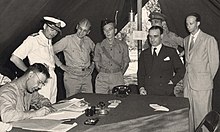Italian Instrument of Surrender
| The Additional Conditions for the Armistice with Italy The Instrument of Surrender of Italy | |
|---|---|
 Marshal Pietro Badoglio (at left) and General Dwight D Eisenhower (at right) with Lord Gort[a], Air Chief Marshal Arthur Tedder[b], Lt. Gen. Sir Noel Mason-MacFarlane[c], and General Harold Alexander[d], aboard the British battleship HMS Nelson prior to the signing of the surrender document at Malta. | |
| Type | Capitulation |
| Signed | 29 September 1943 |
| Location | Malta, aboard the British battleship HMS Nelson |
| Condition | Signed |
| Amendment | Amended by protocol on November 9, 1943 |
| Replaced by | Treaty of peace of February 10, 1947 |
| Signatories | |
| Parties | |
| Ratifiers | |
The Additional Conditions for the Armistice with Italy (Italian: Condizioni aggiuntive di armistizio con l'Italia), or the Instrument of Surrender of Italy as referred by the Allies, was a legal document which was signed between Italy and the Allies at Malta on 29 September 1943.[1]
It was signed by Marshal Pietro Badoglio for Italy, and General Dwight D. Eisenhower for the Allies, at Malta aboard the British battleship HMS Nelson. The term Additional Conditions for the Armistice with Italy was coined by the Italians as they had already signed the Armistice of Cassibile, an armistice ending the hostilities between Italy and the Allies, on 3 September.[2] The agreement signed at Malta is considered to be the 'longer' version of the armistice. For the Allies, it was considered the Instrument of Surrender of Italy.
Background
[edit]
Following the Fall of the Fascist regime in Italy, which saw Benito Mussolini ousted and arrested by King Victor Emmanuel III and replaced as Prime Minister of Italy by Badoglio. The Italians had begun to contact the Allies to cease hostilities between them. On 3 September, the Armistice of Cassibile was signed by General Giuseppe Castellano on behalf of Badoglio and General Walter Bedell Smith on behalf of Eisenhower (Supreme Allied commander for the Mediterranean theatre). The armistice had to take effect on 8 September along with the Badoglio Proclamation.[citation needed]
Before the armistice. Germany had been distrustful of Italy as it believed that Italy was secretly negotiating with the Allies for a separate peace. After the Badoglio Proclamation and for the armistice to take effect on 8 September. Germany began Operation Achse, a campaign to disarm Italian forces and occupy Italy. On 23 September, the Italian Social Republic was established by the Germans with Mussolini, after a German force led by SS Obersturmbannführer Otto Skorzeny rescued him from Campo Imperatore, as the head of state.[3][page needed]
Signing
[edit]The surrender document was signed at 11:30 by Badoglio and Eisenhower respectively aboard HMS Nelson, with both Allied and Italian officers were present in the signing ceremony. The article included that all Italian land, air, and naval forces must surrender to the Allies unconditionally, that Fascist organizations must be dismantled throughout Italy and the Italian dictator Mussolini along with his high-ranking Fascist officials must be handed over to the United Nations. The surrender instrument was immediately in effect.
Aftermath
[edit]On 13 October 1943, the newly-formed government by King Victor Emmanuel III and Badoglio, the Kingdom of the South, the government-in-exile of the Kingdom of Italy,[clarification needed] declared war on Germany and became a co-belligerent fighting alongside the Allies.
See also
[edit]- Badoglio Proclamation
- German Instrument of Surrender
- Japanese Instrument of Surrender
- Kingdom of the South
Notes
[edit]- ^ Governor of Malta
- ^ Commander of the Mediterranean Air Command
- ^ Later head of the Allied Commission in Italy
- ^ Commander of the 15th Army Group
References
[edit]- ^ Garland, Albert N; Smyth, Howard McGaw (1965). Sicily and the Surrender of Italy. United States Army in World War II: Mediterranean Theater of Operations. p. 559.
Appendix D
- ^ Smyth, Howard McGaw (Spring 1948), "The Armistice of Cassibile", Military Affairs, 12 (1): 12–35, doi:10.2307/1982522, JSTOR 1982522
- ^ Di Michele, Vincenzo (2015). The Last Secret of Mussolini. Il Cerchio. ISBN 978-8884744227.
Bibliography
[edit]- Ivan Palermo, The Story of an Armistice , Le Scie, Mondadori, Milan, 1967
External links
[edit]- 1943 in Italy
- September 1943 events
- Italy in World War II
- Instrument of Surrender
- World War II documents
- Treaties of the Kingdom of Italy (1861–1946)
- Italy–United States relations
- Italy–United Kingdom relations
- Treaties concluded in 1943
- Treaties entered into force in 1943
- Dwight D. Eisenhower
- Italian campaign (World War II)
